数字信号论文
- 格式:doc
- 大小:218.02 KB
- 文档页数:10
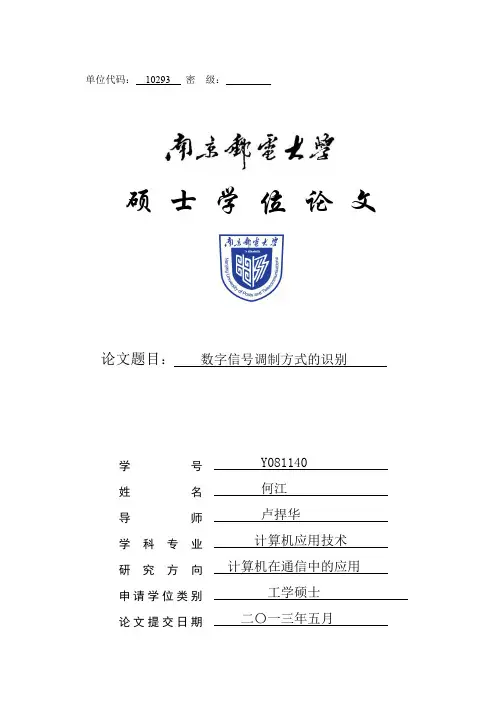
单位代码: 10293 密 级:硕 士 学 位 论 文论文题目: 数字信号调制方式的识别Y081140 何江 卢捍华 计算机应用技术计算机在通信中的应用工学硕士 二〇一三年五月 学号姓名导 师学 科 专 业 研 究 方 向 申请学位类别 论文提交日期Identification of Digital Modulated SignalThesis Submitted to Nanjing University of Posts and Telecommunications for the Degree ofMaster of EngineeringByJang HeSupervisor: Prof. Hanhua LuMay 2013南京邮电大学学位论文原创性声明本人声明所呈交的学位论文是我个人在导师指导下进行的研究工作及取得的研究成果。
尽我所知,除了文中特别加以标注和致谢的地方外,论文中不包含其他人已经发表或撰写过的研究成果,也不包含为获得南京邮电大学或其它教育机构的学位或证书而使用过的材料。
与我一同工作的同志对本研究所做的任何贡献均已在论文中作了明确的说明并表示了谢意。
本人学位论文及涉及相关资料若有不实,愿意承担一切相关的法律责任。
研究生签名:_____________ 日期:____________南京邮电大学学位论文使用授权声明本人授权南京邮电大学可以保留并向国家有关部门或机构送交论文的复印件和电子文档;允许论文被查阅和借阅;可以将学位论文的全部或部分内容编入有关数据库进行检索;可以采用影印、缩印或扫描等复制手段保存、汇编本学位论文。
本文电子文档的内容和纸质论文的内容相一致。
论文的公布(包括刊登)授权南京邮电大学研究生院办理。
涉密学位论文在解密后适用本授权书。
研究生签名:____________ 导师签名:____________ 日期:_____________摘要在现代通信系统中,信号在介质中传输时首先需要在发送端进行调制,变换成为适合在介质中传播的形式。
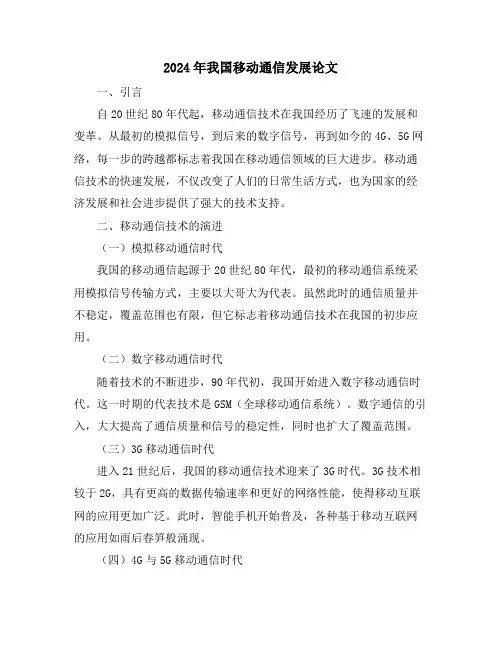
2024年我国移动通信发展论文一、引言自20世纪80年代起,移动通信技术在我国经历了飞速的发展和变革。
从最初的模拟信号,到后来的数字信号,再到如今的4G、5G网络,每一步的跨越都标志着我国在移动通信领域的巨大进步。
移动通信技术的快速发展,不仅改变了人们的日常生活方式,也为国家的经济发展和社会进步提供了强大的技术支持。
二、移动通信技术的演进(一)模拟移动通信时代我国的移动通信起源于20世纪80年代,最初的移动通信系统采用模拟信号传输方式,主要以大哥大为代表。
虽然此时的通信质量并不稳定,覆盖范围也有限,但它标志着移动通信技术在我国的初步应用。
(二)数字移动通信时代随着技术的不断进步,90年代初,我国开始进入数字移动通信时代。
这一时期的代表技术是GSM(全球移动通信系统)。
数字通信的引入,大大提高了通信质量和信号的稳定性,同时也扩大了覆盖范围。
(三)3G移动通信时代进入21世纪后,我国的移动通信技术迎来了3G时代。
3G技术相较于2G,具有更高的数据传输速率和更好的网络性能,使得移动互联网的应用更加广泛。
此时,智能手机开始普及,各种基于移动互联网的应用如雨后春笋般涌现。
(四)4G与5G移动通信时代近年来,随着4G技术的广泛应用,我国的移动通信进入了全新的发展阶段。
4G技术提供了更快的网络速度和更低的延迟,进一步推动了移动互联网的普及和应用。
而5G技术的出现,更是为我国的移动通信带来了新的飞跃。
5G网络具有超高的数据传输速率、极低的延迟和广泛的连接能力,将为实现万物互联、智能化社会提供强大的技术支持。
三、我国移动通信发展的影响因素(一)政策推动政府在移动通信发展中起到了关键的作用。
我国政府通过制定相关的政策和规划,为移动通信的发展提供了有力的支持。
例如,在频谱分配、基础设施建设、技术研发等方面,政府都给予了大力的支持和推动。
(二)市场需求随着经济的发展和人民生活水平的提高,人们对通信服务的需求也不断增加。
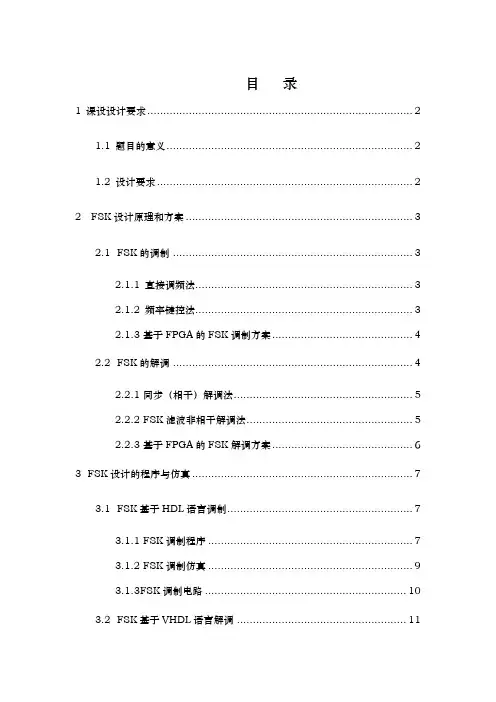
目录1 课设设计要求 (2)1.1 题目的意义 (2)1.2 设计要求 (2)2 FSK设计原理和方案 (3)2.1 FSK的调制 (3)2.1.1 直接调频法 (3)2.1.2 频率键控法 (3)2.1.3 基于FPGA的FSK调制方案 (4)2.2 FSK的解调 (4)2.2.1 同步(相干)解调法 (5)2.2.2 FSK滤波非相干解调法 (5)2.2.3 基于FPGA的FSK解调方案 (6)3 FSK设计的程序与仿真 (7)3.1 FSK基于HDL语言调制 (7)3.1.1 FSK调制程序 (7)3.1.2 FSK调制仿真 (9)3.1.3FSK调制电路 (10)3.2 FSK基于VHDL语言解调 (11)3.2.1 FSK解调程序 (11)3.2.2FSK解调仿真 (13)3.2.3 FSK解调电路 (13)4心得体会 (14)参考文献 (15)1 课设设计要求1.1 题目的意义数字调制技术是现代通信的一个重要内容,在数字通信系统中由于数字信号具有丰富的低频成份,不宜进行无线传输或长距离电缆传输,因而需要将基带信号进行数字调制(Digital Modulation)。
数字调制同时也是数字信号频分复用的基本技术。
数字调制与模拟调制都属于正弦波调制,但是,数字调制是调制信号为数字型的正弦波调制,因而数字调制具有自身的特点一般说来数字调制技术分为两种类型:一是把数字基带信号当作模拟信号的特殊情况来处理;二是利用数字信号的离散取值去键控载波,从而实现数字调制。
后一种方法通常称为键控法。
例如可以对载波的振幅、频率及相位进行键控,便可获得振幅键控(ASK)、移频键控(FSK)、相移键控(PSK)等调制方式。
移频键控(FSK)是数字信息传输中使用较早的一种调制形式,它由于其抗干扰及衰落性较好且技术容易实现,因而在集散式工业控制系统中被广泛采用。
以往的键控移频调制解调器采用“定功能集成电路+连线”式设计;集成块多,连线复杂,容易出错,且体积较大,本设计采用Lattice公司的FPGA芯片,有效地缩小了系统的体积,降低了成本,增加了可靠性,同时系统采用VHDL语言进行设计,具有良好的可移植性及产品升级的系统性。
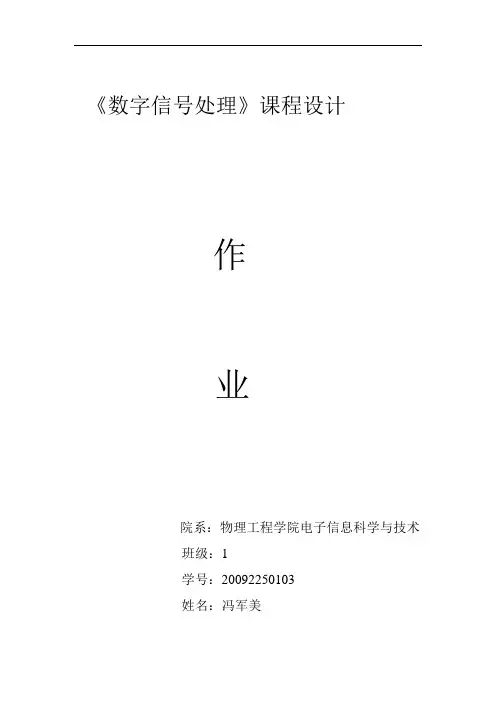
《数字信号处理》课程设计作业院系:物理工程学院电子信息科学与技术班级:1学号:20092250103姓名:冯军美实验一:音乐信号音谱和频谱的观察1.实验方案读取音乐信号并将信号装换为单声道的,并输出信号的波形图和频谱图%2.源程序clear all; close all;clc[x,fs,bit]=wavread('F:\费玉清-一剪梅00_01_23-00_01_28.wav');%读取音乐信号,其中x为截取的音乐信号size(x) %看音乐信号是单声道还是双声道sound(x,fs); %听原始音乐信号x=x(:,1); %获取单声道音乐信号N=length(x); %N为音乐信号的长度figureplot(x) %画音乐信号的连续波形grid on %产生虚线格title('音乐信号时域波型') %标注图注xlabel('Time') %x坐标ylabel('Magnitude') %y坐标F1=fft(x,N); %做音乐信号的N点快速傅里叶变换w=2/N*[0:N-1]; %w为连续频谱的数字角频率横坐标figureplot(w,abs(F1)) %连续频谱图grid ontitle('音乐信号频域波型')xlabel('Frequency/Hz')ylabel('Magnitude')%不同抽样频率下听取的音乐信号% sound(x,2*fs);sound(x,fs/2);3.输出波形0.511.522.5x 105-1-0.8-0.6-0.4-0.200.20.40.60.81音乐信号时域波型TimeM a g n i t u d e00.20.40.60.81 1.2 1.4 1.6 1.8250010001500200025003000音乐信号频域波型Frequency/HzM a g n i t u d e4.输出结果分析从音谱可看到音乐信号分布在整个时间轴上,幅值分布有规律;从频谱可看到音乐信号主要分布在低频段,高频成分较少,在0.4pi 以后几乎无音乐信号的频谱成分了5.回放声音信号特征的描述和解释当抽样率变为原来的2后,可听出音乐信号,但音乐明显比原来速度播放的快了,播放时间也比原来缩短了,而且音乐中听到的更多的是高频成分。
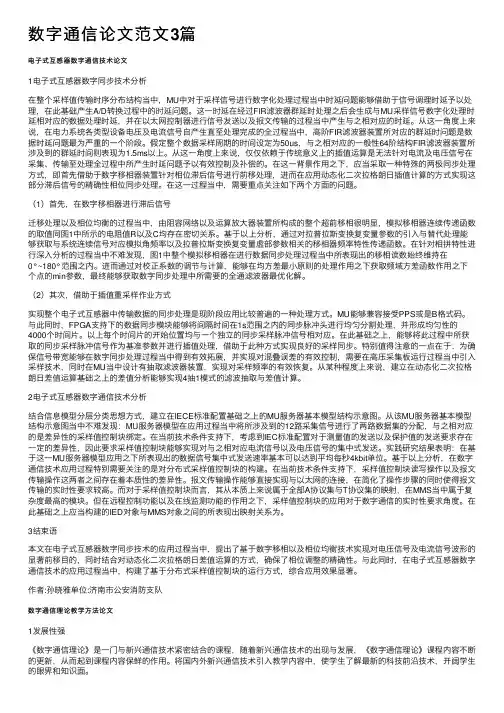
数字通信论⽂范⽂3篇电⼦式互感器数字通信技术论⽂1电⼦式互感器数字同步技术分析在整个采样值传输时序分布结构当中,MU中对于采样信号进⾏数字化处理过程当中时延问题能够借助于信号调理时延予以处理,在此基础产⽣A/D转换过程中的时延问题。
这⼀时延在经过FIR滤波器群延时处理之后会⽣成与MU采样信号数字化处理时延相对应的数据处理时延,并在以太⽹控制器进⾏信号发送以及报⽂传输的过程当中产⽣与之相对应的时延。
从这⼀⾓度上来说,在电⼒系统各类型设备电压及电流信号⾃产⽣直⾄处理完成的全过程当中,⾼阶FIR滤波器装置所对应的群延时问题是数据时延问题最为严重的⼀个阶段。
假定整个数据采样周期的时间设定为50us,与之相对应的⼀般性64阶结构FIR滤波器装置所涉及到的群延时间则表现为1.5ms以上。
从这⼀⾓度上来说,仅仅依赖于传统意义上的插值运算是⽆法针对电流及电压信号在采集、传输⾄处理全过程中所产⽣时延问题予以有效控制及补偿的。
在这⼀背景作⽤之下,应当采取⼀种特殊的两极同步处理⽅式,即⾸先借助于数字移相器装置针对相位滞后信号进⾏前移处理,进⽽在应⽤动态化⼆次拉格朗⽇插值计算的⽅式实现这部分滞后信号的精确性相位同步处理。
在这⼀过程当中,需要重点关注如下两个⽅⾯的问题。
(1)⾸先,在数字移相器进⾏滞后信号迁移处理以及相位均衡的过程当中,由阻容⽹络以及运算放⼤器装置所构成的整个超前移相很明显,模拟移相器连续传递函数的取值同图1中所⽰的电阻值R以及C均存在密切关系。
基于以上分析,通过对拉普拉斯变换复变量参数的引⼊与替代处理能够获取与系统连续信号对应模拟⾓频率以及拉普拉斯变换复变量虚部参数相关的移相器频率特性传递函数。
在针对相拼特性进⾏深⼊分析的过程当中不难发现,图1中整个模拟移相器在进⾏数据同步处理过程当中所表现出的移相读数始终维持在0°~180°范围之内。
进⽽通过对校正系数的调节与计算,能够在均⽅差最⼩原则的处理作⽤之下获取频域⽅差函数作⽤之下个点的min参数,最终能够获取数字同步处理中所需要的全通滤波器最优化解。
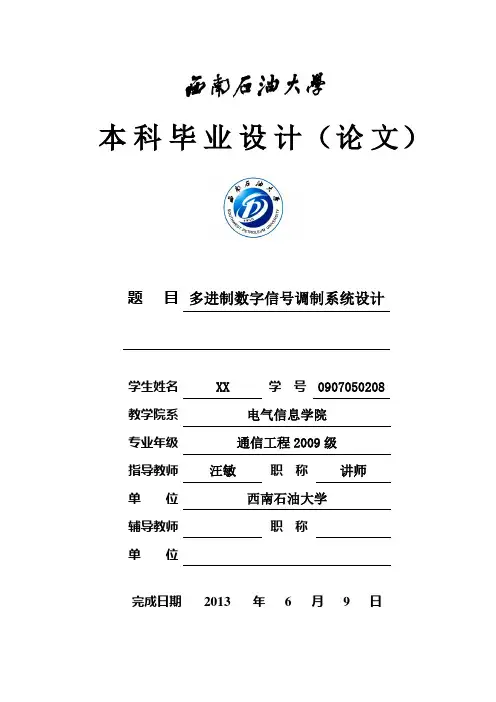
本科毕业设计(论文)题目多进制数字信号调制系统设计学生姓名XX 学号0907050208教学院系电气信息学院专业年级通信工程2009级指导教师汪敏职称讲师单位西南石油大学辅导教师职称单位完成日期2013 年 6 月9 日Southwest Petroleum UniversityGraduation ThesisSystem Design of M-ary Digital Signal ModulationGrade: 2009Name:Liu ShaSpeciality: Telecommunications EngineeringInstructor: Wang MinSchool of Electrical Engineering and Information摘要由于数字通信系统的实际信道大多数具有带通特性,所以必须用数字基带信号对载波进行数字调制。
也因此,数字调制方法成为了当今的热点研究对象,其中最常用的一种是键控法。
在带通二进制键控系统中,每个码元只能传输1比特的信息,其频带利用率不高,而频率资源又是极其宝贵的,为了能提高频带利用率,最有效的办法是使一个码元能够传输多个比特的信息,这就是本文主要研究的多进制数字调制系统,包括多进制数字振幅调制(MASK)、多进制数字频率调制(MFSK)和多进制数字相位调制(MPSK)。
多进制键控系统可以看作是二进制键控系统的推广,可以大大提高频带利用率,而且因其抗干扰性能强、误码性能好,能更好的满足未来通信的高要求,所以研究多进制数字调制系统是很有必要的。
本文通过对多进制数字调制系统的研究,采用基于EP2C35F672C8芯片,运用VHDL硬件描述语言,完成了多功能调制器的模块化设计。
首先实现多进制数字振幅调制(MASK)、多进制数字频率调制(MFSK)和多进制数字相位调制(MPSK) 的设计,将时钟信号通过m序列发生器后产生随机的二进制序列,再通过串/并转换器转换成并行的多进制基带信号;其次分别实现数字调制模块2-M电平变换器、分频器以及四相载波发生器的设计;最后在顶层文件中调用并结合四选一多路选择器,从而完成多功能调制器的设计。
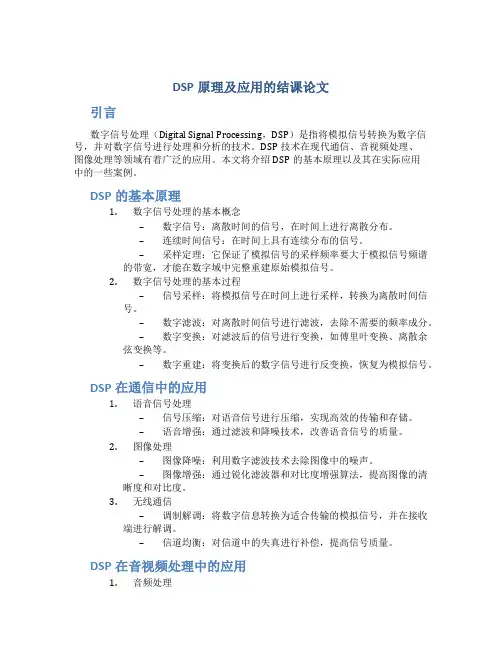
DSP原理及应用的结课论文引言数字信号处理(Digital Signal Processing,DSP)是指将模拟信号转换为数字信号,并对数字信号进行处理和分析的技术。
DSP技术在现代通信、音视频处理、图像处理等领域有着广泛的应用。
本文将介绍DSP的基本原理以及其在实际应用中的一些案例。
DSP的基本原理1.数字信号处理的基本概念–数字信号:离散时间的信号,在时间上进行离散分布。
–连续时间信号:在时间上具有连续分布的信号。
–采样定理:它保证了模拟信号的采样频率要大于模拟信号频谱的带宽,才能在数字域中完整重建原始模拟信号。
2.数字信号处理的基本过程–信号采样:将模拟信号在时间上进行采样,转换为离散时间信号。
–数字滤波:对离散时间信号进行滤波,去除不需要的频率成分。
–数字变换:对滤波后的信号进行变换,如傅里叶变换、离散余弦变换等。
–数字重建:将变换后的数字信号进行反变换,恢复为模拟信号。
DSP在通信中的应用1.语音信号处理–信号压缩:对语音信号进行压缩,实现高效的传输和存储。
–语音增强:通过滤波和降噪技术,改善语音信号的质量。
2.图像处理–图像降噪:利用数字滤波技术去除图像中的噪声。
–图像增强:通过锐化滤波器和对比度增强算法,提高图像的清晰度和对比度。
3.无线通信–调制解调:将数字信息转换为适合传输的模拟信号,并在接收端进行解调。
–信道均衡:对信道中的失真进行补偿,提高信号质量。
DSP在音视频处理中的应用1.音频处理–声音合成:利用数字信号处理算法合成逼真的人声、乐器音色等。
–音频编码:将音频信号转换为数字数据流,实现高效的传输和存储。
2.视频处理–视频压缩:使用从模拟信号到数字信号的转换、DCT、运动补偿等技术,将视频信号压缩到较小的数据量。
–视频解码:将压缩后的视频信号进行解码,恢复为原始的视频图像。
结论DSP技术在现代通信、音视频处理等领域有着广泛的应用。
本文介绍了DSP的基本原理,以及在通信和音视频处理中的一些具体应用。
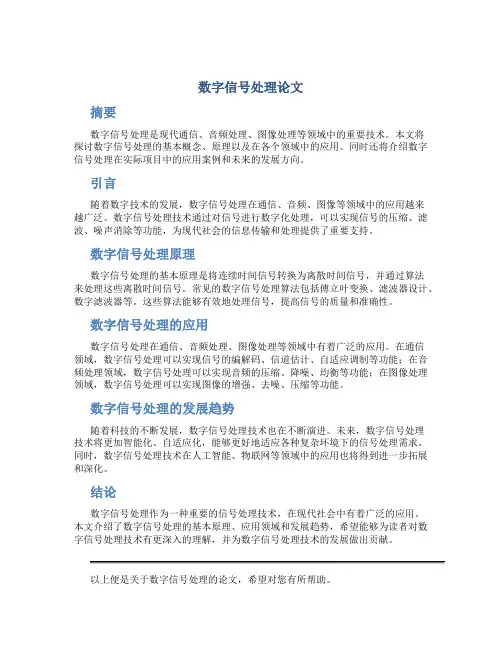
数字信号处理论文摘要数字信号处理是现代通信、音频处理、图像处理等领域中的重要技术。
本文将探讨数字信号处理的基本概念、原理以及在各个领域中的应用。
同时还将介绍数字信号处理在实际项目中的应用案例和未来的发展方向。
引言随着数字技术的发展,数字信号处理在通信、音频、图像等领域中的应用越来越广泛。
数字信号处理技术通过对信号进行数字化处理,可以实现信号的压缩、滤波、噪声消除等功能,为现代社会的信息传输和处理提供了重要支持。
数字信号处理原理数字信号处理的基本原理是将连续时间信号转换为离散时间信号,并通过算法来处理这些离散时间信号。
常见的数字信号处理算法包括傅立叶变换、滤波器设计、数字滤波器等。
这些算法能够有效地处理信号,提高信号的质量和准确性。
数字信号处理的应用数字信号处理在通信、音频处理、图像处理等领域中有着广泛的应用。
在通信领域,数字信号处理可以实现信号的编解码、信道估计、自适应调制等功能;在音频处理领域,数字信号处理可以实现音频的压缩、降噪、均衡等功能;在图像处理领域,数字信号处理可以实现图像的增强、去噪、压缩等功能。
数字信号处理的发展趋势随着科技的不断发展,数字信号处理技术也在不断演进。
未来,数字信号处理技术将更加智能化、自适应化,能够更好地适应各种复杂环境下的信号处理需求。
同时,数字信号处理技术在人工智能、物联网等领域中的应用也将得到进一步拓展和深化。
结论数字信号处理作为一种重要的信号处理技术,在现代社会中有着广泛的应用。
本文介绍了数字信号处理的基本原理、应用领域和发展趋势,希望能够为读者对数字信号处理技术有更深入的理解,并为数字信号处理技术的发展做出贡献。
以上便是关于数字信号处理的论文,希望对您有所帮助。
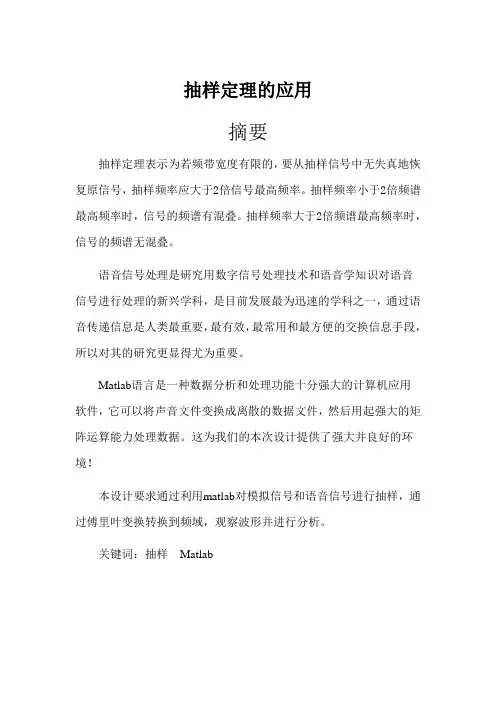
抽样定理的应用摘要抽样定理表示为若频带宽度有限的,要从抽样信号中无失真地恢复原信号,抽样频率应大于2倍信号最高频率。
抽样频率小于2倍频谱最高频率时,信号的频谱有混叠。
抽样频率大于2倍频谱最高频率时,信号的频谱无混叠。
语音信号处理是研究用数字信号处理技术和语音学知识对语音信号进行处理的新兴学科,是目前发展最为迅速的学科之一,通过语音传递信息是人类最重要,最有效,最常用和最方便的交换信息手段,所以对其的研究更显得尤为重要。
Matlab语言是一种数据分析和处理功能十分强大的计算机应用软件,它可以将声音文件变换成离散的数据文件,然后用起强大的矩阵运算能力处理数据。
这为我们的本次设计提供了强大并良好的环境!本设计要求通过利用matlab对模拟信号和语音信号进行抽样,通过傅里叶变换转换到频域,观察波形并进行分析。
关键词:抽样Matlab目录一、设计目的: (2)二、设计原理: (2)1、抽样定理 (2)2、MATLAB简介 (2)3、语音信号 (3)4、Stem函数绘图 (3)三、设计内容: (4)1、已知g1(t)=cos(6πt),g2(t)=cos(14πt),g3(t)=cos(26πt),以抽样频率fsam=10Hz对上述三个信号进行抽样。
在同一张图上画出g1(t),g2(t),g3(t)及其抽样点,对所得结果进行讨论。
(4)2、选取三段不同的语音信号,并选取适合的同一抽样频率对其进行抽样,画出抽样前后的图形,并进行比较,播放抽样前后的语音。
(6)3、选取合适的点数,对抽样后的三段语音信号分别做DFT,画图并比较。
(10)四、总结 (12)五、参考文献 (13)绪论当今,随着信息时代和数字世界的到来,数字信号处理已成为今一门极其重要的学科和技术领域,数字信号处理技术正飞速发展,它不但自成一门学科,更是以不同形式影响和渗透到其他学科;它与国民经济息息相关,与国防建设紧密相连;它影响或改变着我们的生产、生活方式,因此受到人们普遍的关注数字化、智能化和网络化是当代信息技术发展的大趋势,而数字化是智能化和网络化的基础,实际生活中遇到的信号多种多样,例如广播信号、电视信号、雷达信号、通信信号、导航信号等等。
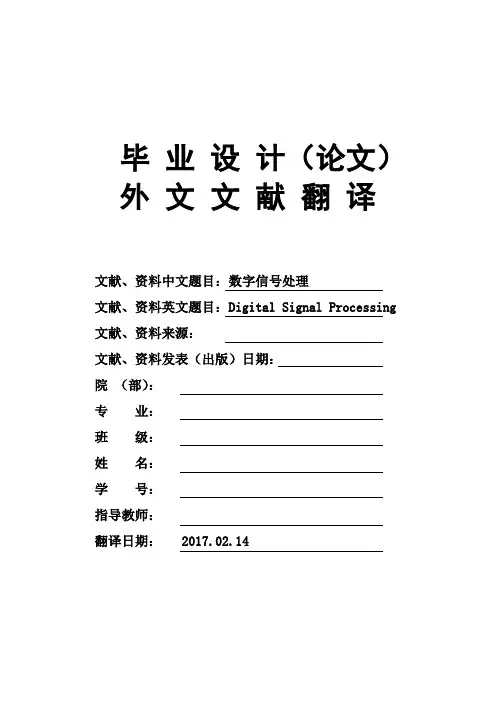
毕业设计(论文)外文文献翻译文献、资料中文题目:数字信号处理文献、资料英文题目:Digital Signal Processing 文献、资料来源:文献、资料发表(出版)日期:院(部):专业:班级:姓名:学号:指导教师:翻译日期: 2017.02.14数字信号处理一、导论数字信号处理(DSP)是由一系列的数字或符号来表示这些信号的处理的过程的。
数字信号处理与模拟信号处理属于信号处理领域。
DSP包括子域的音频和语音信号处理,雷达和声纳信号处理,传感器阵列处理,谱估计,统计信号处理,数字图像处理,通信信号处理,生物医学信号处理,地震数据处理等。
由于DSP的目标通常是对连续的真实世界的模拟信号进行测量或滤波,第一步通常是通过使用一个模拟到数字的转换器将信号从模拟信号转化到数字信号。
通常,所需的输出信号却是一个模拟输出信号,因此这就需要一个数字到模拟的转换器。
即使这个过程比模拟处理更复杂的和而且具有离散值,由于数字信号处理的错误检测和校正不易受噪声影响,它的稳定性使得它优于许多模拟信号处理的应用(虽然不是全部)。
DSP算法一直是运行在标准的计算机,被称为数字信号处理器(DSP)的专用处理器或在专用硬件如特殊应用集成电路(ASIC)。
目前有用于数字信号处理的附加技术包括更强大的通用微处理器,现场可编程门阵列(FPGA),数字信号控制器(大多为工业应用,如电机控制)和流处理器和其他相关技术。
在数字信号处理过程中,工程师通常研究数字信号的以下领域:时间域(一维信号),空间域(多维信号),频率域,域和小波域的自相关。
他们选择在哪个领域过程中的一个信号,做一个明智的猜测(或通过尝试不同的可能性)作为该域的最佳代表的信号的本质特征。
从测量装置对样品序列产生一个时间或空间域表示,而离散傅立叶变换产生的频谱的频率域信息。
自相关的定义是互相关的信号本身在不同时间间隔的时间或空间的相关情况。
二、信号采样随着计算机的应用越来越多地使用,数字信号处理的需要也增加了。
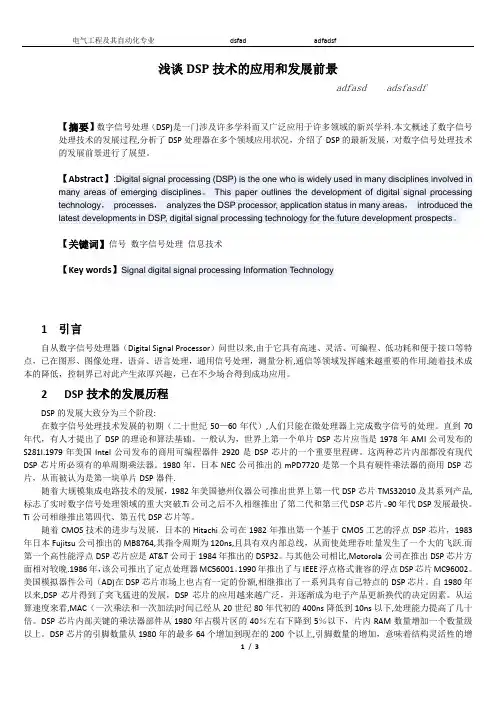
浅谈DSP技术的应用和发展前景adfasd adsfasdf【摘要】数字信号处理(DSP)是一门涉及许多学科而又广泛应用于许多领域的新兴学科.本文概述了数字信号处理技术的发展过程,分析了DSP处理器在多个领域应用状况,介绍了DSP的最新发展,对数字信号处理技术的发展前景进行了展望。
【Abstract】:Digital signal processing (DSP) is the one who is widely used in many disciplines involved in many areas of emerging disciplines。
This paper outlines the development of digital signal processing technology,processes,analyzes the DSP processor, application status in many areas,introduced the latest developments in DSP, digital signal processing technology for the future development prospects。
【关键词】信号数字信号处理信息技术【Key words】Signal digital signal processing Information Technology1引言自从数字信号处理器(Digital Signal Processor)问世以来,由于它具有高速、灵活、可编程、低功耗和便于接口等特点,已在图形、图像处理,语音、语言处理,通用信号处理,测量分析,通信等领域发挥越来越重要的作用.随着技术成本的降低,控制界已对此产生浓厚兴趣,已在不少场合得到成功应用。
2DSP技术的发展历程DSP的发展大致分为三个阶段:在数字信号处理技术发展的初期(二十世纪50—60年代),人们只能在微处理器上完成数字信号的处理。
Adaptive frequency estimation of three-phasepower systems$Reza Arablouei a,n,1,Kutluyıl Doğançay a,1,Stefan Werner b,1a School of Engineering,University of South Australia,Mawson Lakes,SA5095,Australiab Department of Signal Processing and Acoustics,School of Electrical Engineering,Aalto University,Espoo,Finlanda r t i c l e i n f oArticle history:Received14April2014Received in revised form18October2014Accepted25November2014Available online4December2014Keywords:Adaptive signal processingFrequency estimationInverse power methodLinear predictive modelingTotal least-squaresa b s t r a c tThe frequency of a three-phase power system can be estimated by identifying theparameter of a second-order autoregressive(AR2)linear predictive model for thecomplex-valuedαβsignal of the system.Since,in practice,both input and output ofthe AR2model are observed with noise,the recursive least-squares(RLS)estimate of thesystem frequency using this model is biased.We show that the estimation bias can beevaluated and subtracted from the RLS estimate to yield a bias-compensated RLS(BCRLS)estimate if the variance of the noise is known a priori.Moreover,in order to simulta-neously compensate for the noise on both input and output of the AR2model,we utilizethe concept of total least-square(TLS)estimation and calculate a recursive TLS(RTLS)estimate of the system frequency by employing the inverse power method.Unlike theBCRLS algorithm,the RTLS algorithm does not require the prior knowledge of the noisevariance.We prove mean convergence and asymptotic unbiasedness of the BCRLS andRTLS algorithms.Simulation results show that the RTLS algorithm outperforms the RLSand BCRLS algorithms as well as a recently-proposed widely-linear TLS-based algorithm inestimating the frequency of both balanced and unbalanced three-phase power systems.&2014Elsevier B.V.All rights reserved.1.IntroductionIn electric power grids,the system frequency nor-mally fluctuates around its nominal value within anacceptable range.Deviation of the system frequencyfrom its nominal range represents an imbalancebetween load and generation,which is a critical event.Therefore,it is imperative to closely watch the possiblevariations in the frequency.Most protection-and-control applications in electric power systems requireaccurate and fast estimation of the system frequency.An erroneous estimate of the frequency may cause acatastrophic grid failure due to inadequate or delayedload shedding[2–7].In three-phase systems,none of the single phases canfaithfully characterize the whole system and its properties.Therefore,a robust frequency estimator should take intoaccount the information of all three phases[8–12].Clarke'stransform applied to the voltages of a three-phase powersystem produces a complex-valued signal(known as theαβsignal)that incorporates the information of the three phases.In many applications,theαβsignal can be considered as afaithful representative for a three-phase system[13].Thephase voltages are digitized at the measurement points byquantizing the samples taken at uniform intervals.Therefore,in practice,the observed voltage data and consequently theαβsignal are contaminated with noise/error.From a signal-processing point of view,the noisy samplesof theαβsignal and the sampling rate comprise the availabledata while the amplitudes of the three phase voltages,Contents lists available at ScienceDirectjournal homepage:/locate/sigproSignal Processing/10.1016/j.sigpro.2014.11.0180165-1684/&2014Elsevier B.V.All rights reserved.☆This work was partially presented in the European Signal ProcessingConference,Lisbon,Portugal,September2014[1].n Corresponding author.Tel.:þ61883023316.E-mail address:arary003@.au(R.Arablouei).1EURASIP member.Signal Processing109(2015)290–300the initial phase angle,and the system frequency are the unknown parameters.A plethora of techniques have been developed to extract these parameters,particularly the system frequency,from the observable data.Some of the most well-known frequency estimation techniques are based on zero-crossing[14],phase-locked loop[15–17],discrete Fourier transform[18],Viterbi algorithm[19],extended Kalman filter [20],Newton's method[21],data(auto)correlation[22–24], demodulation[25],least-error-squares curve fitting[26],least mean-square(LMS)[27],least mean-phase[28],adaptive notch filters[29,30],and minimum-variance distortionless response(MVDR)spectrum[31].In order to estimate the system frequency within the realm of linear adaptive signal processing,time evolution of the noiselessαβsignal can be modeled by either a first-order autoregressive(AR1)[27]or a second-order autoregressive (AR2)linear predictive model[32–36].The AR1is suitable for balanced three-phase systems,i.e.,when the voltage magni-tudes of the three phases are identical.It relates two con-secutive noiseless samples of theαβsignal of a balanced system via a single complex-valued parameter.The modulus of this parameter is equal to unity and its phase angle is equal to the system angular frequency multiplied by the sampling interval.Therefore,the system frequency can be estimated by identifying the parameter of the AR1model from the noisy voltage observations using any linear estimation technique, e.g.,the LMS algorithm as proposed in[27].The AR1-based frequency estimators lose their accuracy when the system is unbalanced,since in such systems,the strictly-linear AR1model becomes inexact.Augmenting the AR1model using the notion of widely-linear modeling[37]can provide a remedy for this weakness in handling the unba-lanced three-phase power systems[38–40].The frequency estimation techniques based on the widely-linear AR1model can estimate the system frequency by identifying the para-meters of the widely-linear model even when the system in unbalanced.However,despite introducing an extra complex-valued model parameter,the widely-linear-AR1-based meth-ods cannot cope with the cases of severe unbalancedness,e.g., when the readings of two phases drop to zero.This is mainly due to the inherent limitation of the widely-linear AR1model for such events caused by its approximate nature.On the other hand,the AR2model linearly relates three consecutive noiseless samples of theαβsignal via a single real-valued parameter that is equal to the cosine of the product of the system angular frequency and the sampling interval.Thus, the system frequency can be estimated by identifying the parameter of the AR2model from the noisy observations of theαβsignal while being harmlessly oblivious to the values of the phase voltage magnitudes and the initial phase angle.In other words,since the parameter of the AR2model depends only on the system frequency and the sampling interval,any frequency estimator built on this model is virtually insensitive to the balance state of the three-phase power system.As theαβsignal is observed with noise,a reliable frequency estimation technique based on the AR2model should minimize the effect of noise.In[34,35],the least-squares(LS)method has been used for this purpose.A recursive LS(RLS)frequency estimator has also been pro-posed in[41].The LS-based approaches are best suited to counter the effect of the noise at the output of a linear model.However,since in the AR2model,the input of the model is also subject to observational noise,the LS-based frequency estimators are biased.Such bias can falsely indicate a shift in the system frequency and invoke unne-cessary corrective actions,which may have harmful fallouts. Thus,any bias in frequency estimation can seriously com-promise the stability and reliability of a power system.One way to eliminate the estimation bias is to evaluate the bias separately and subtract it from the biased estimate [42–44].The evaluation of the bias usually requires prior knowledge of the noise variance or an extra procedure for estimating the noise variance.Alternatively,the total least-squares(TLS)estimation technique can be utilized to compen-sate for the noise on both input and output of the AR2model. TLS is a fitting method that improves accuracy of the LS estimation techniques when both the input and output data of a linear system are subject to observational error.It finds an estimate for the system parameters that fits the input to the output with minimum perturbation in the data.A TLS estima-tor can eliminate the estimation bias induced by the input noise without performing any explicit bias calculation[45–47]. Two efficient recursive TLS algorithms have been developed in [48,49]utilizing the line-search optimization.The latter mini-mize a Rayleigh-quotient cost function and the former employs the inverse power method[50].The TLS technique has recently been utilized to estimate the frequency of three-phase power systems based on the widely-linear AR1model[51,52].In this paper,we show that the RLS algorithm based on the AR2model for the noiselessαβsignal is biased when applied to adaptive frequency estimation of three-phase power systems at the presence of noise.In order to obtain unbiased estimates while employing the AR2model,we develop a bias-com-pensated RLS(BCRLS)algorithm as well as a recursive TLS (RTLS)algorithm.We derive the BCRLS algorithm by evaluating the estimation bias and subtracting it from the biased RLS estimate.To derive the RTLS algorithm,we calculate the TLS estimate of the AR2model parameter by implementing a single iteration of the inverse power method at each time instant. Unlike the algorithms proposed in[48,49],our RTLS algorithm does not implement any line-search optimization.We show that the BCRLS and RTLS algorithms are convergent in the mean and asymptotically unbiased.We verify the effectiveness of the proposed algorithms in estimating the frequency of both balanced and unbalanced three-phase power systems through simulated experiments.2.Signal and system modelThe phase-to-neutral voltages of a three-phase power system,sampled at the rate of1=τ,are represented byv a;n¼V a cos2πfτnþθðÞ;v b;n¼V b cos2πfτnþθÀ2π3andv c;n¼V c cos2πfτnþθþ2π3where f is the system frequency,V a,V b,and V c are the peak voltage values,θis an initial phase angle,and n is the integer time index.In practice,these voltages areR.Arablouei et al./Signal Processing109(2015)290–300291measured with noise.We express the noisy measurements as~va ;n ¼v a ;n þηa ;n ;~vb ;n ¼v b ;n þηb ;n ;and~vc ;n ¼v c ;n þηc ;n where ηa ;n ,ηb ;n ,and ηc ;n denote the additive noise of the respective phases.We assume that the noises are zero-mean i.i.d.Thus,we have E ηa ;n ÂüE ηb ;n ÂüE ηc ;n Âü0;E η2a ;n h i ¼σ2a ;E η2b ;n h i¼σ2b ;and E η2c ;n h i¼σ2c :Application of the Clarke's transform to the noisy three-phase voltages results in v α;n v β;n "#þηα;n ηβ;n "#¼ffiffiffi23r 1À1=2À1=20ffiffiffi3p =2Àffiffiffi3p =2"#v a ;nv b ;n v c ;n264375þηa ;n ηb ;n ηc ;n 2643750B @1C A :This transformation yields a complex-valued voltage signal (known as the αβsignal)that can represent the three-phase power system.The noiseless αβsignal is calculated as v n ¼v α;n þjv β;n¼A þjB ðÞcos 2πf τn þθðÞþB þjC ðÞsin 2πf τn þθðÞ;ð1ÞwhereA ¼ffiffiffi23r V a þ12ffiffiffi6p V b þV c ðÞ;B ¼À12ffiffiffi2p V b ÀV c ðÞ;and C ¼1ffiffiffi3r V bþV c ðÞ:Writing the noisy αβsignal as ~vn ¼v n þηn ;ð2Þthe additive complex noise,ηn ,is related to the noise at the individual phases viaηn ¼ηα;n þj ηβ;n¼ffiffiffi2r ηa ;n Àηb ;n Àηc ;n þj ffiffiffi2p ηb ;n Àηc ;n ÀÁ:In Appendix A ,we show that the time evolution of thenoiseless αβsignal,v n ,can be described via a second-order autoregressive (AR2)linear predictive model expressed as12v n À2þv n ðÞ¼hv n À1ð3Þwhere h ¼cos 2πf τðÞð4ÞThis model relates the system frequency to three conse-cutive noiseless voltage samples of the three phases through its real-valued parameter h .Using (3)and (4),the system frequency can be extracted from any three consecutive noiseless samples of the αβsignal provided that 0o 2πf τo πor τo12f:However,since the measured samples are noisy,the identification of the model parameter h should be per-formed via a linear estimation technique.Given an esti-mate of h at time instant n ,denoted by ^hn ,the system frequency estimate is calculated by ^f n ¼1cos À1^h n :3.Recursive least squaresBased on the model (3),an exponentially-weighted LS estimate of h at time instant n from the noisy αβsignal is given by [53]w n ¼argmin wjj y n Àw x n jj 2ð5Þwherex n ¼Λ~v n À1~v n À2…~v 1~v02666666437777775andy n ¼Λ2~v n À2þ~v n ~v n À3þ~vn À1…~v 0þ~v 2~v À1þ~v 12666666437777775are the exponentially-weighted input and output datavectors,respectively,Λ¼diag 1;ffiffiffiλp ;…;ffiffiffiffiffiffiffiffiffiffiλn À2p ;ffiffiffiffiffiffiffiffiffiffiλn À1p n ois an exponential weighting matrix and 0{λo 1is the forgetting factor.A recursive solution for the optimization problem of (5),called the RLS estimate,is given as [53]w n ¼p n r nð6Þwhere p n is the exponentially-weighted time-averaged covariance of the input and output computed as p n ¼x H n y n¼12∑n i ¼1λn Ài ~vni À1~v i À2þ~v i ðÞ¼λp n À1þ1~v n n À1~v n À2þ~v n ðÞð7ÞR.Arablouei et al./Signal Processing 109(2015)290–300292and r n is the exponentially-weighted time-averaged var-iance of the input computed as r n ¼x H n x n¼∑ni ¼1λn Ài ~v n i À1~v i À1¼λr n À1þ~vn À12:ð8ÞNote that we consider w n a recursive estimate because p n and r n can be updated recursively.3.1.Estimation biasAs n -1,the RLS estimate w n converges in the mean [53].Thus,we have w 1¼lim n -1E w n ½¼lim n -1E pn n!:ð9ÞApplying Slutsky's theorem [54]to (9)yields w 1¼p 1r 1ð10Þwherep 1¼lim n -1E p nÂÃð11Þandr 1¼lim n -1E r n ½ :ð12ÞIn Appendix B ,we show that p 1¼hD 1Àλð13Þand r 1¼D þσ2ð14ÞwhereD ¼B 2þA 2þC 2and σ2¼23σ2a þσ2b þσ2c ÀÁ:Substituting (13)and (14)into (10)gives w 1¼hD:ð15ÞIt is seen from (15)that,when the noise is present,i.e.,σ2a 0,the LS estimate is biased.This is due to the fact that the LS estimation techniques only compensate for the effect of the noise at the output of the underlying linear model and neglect the effect of the noise at the input.The estimation bias of the LS approach is b ¼w 1Àh ¼Àh σ2D þσ2:4.Bias-compensated recursive least squaresA bias-compensated RLS (BCRLS)estimate can bedevised by subtracting the LS estimation bias from the RLS estimate as ωn ¼w n Àb¼p n r n þh σ2D þσ2:ð16ÞSince h and D in (16)are not known a priori ,they need to be substituted by some known quantities.The parameter h can be replaced with its most recent estimate ωn À1.Considering (14)and taking r n as an instantaneous approx-imation for r 1,D can also be replaced with 1ÀλðÞr n Àσ2.Consequently,the BCRLS estimate is stated as ωn ¼p n r n þσ21ÀλðÞr nωn À1:ð17ÞNote that this estimate still requires the prior knowledge of the noise variance σ2.We list the BCRLS algorithm in Table 1.4.1.Convergence in the meanWhen the forgetting factor,λ,is close to unity (λ-1),after a sufficiently large number of iterations,p n and r n converge to p 1and r 1,respectively.Subsequently,taking the expectation of both sides of (17)results in ωn p 1r σ1ÀλðÞr ωn À1ð18Þwhere ωn ¼E ωn ½ :Using (13),(14)and (18)is written as ωn ¼hD D þσ2σωn À1:ð19ÞSince we have 0oσ2o 1;the recursion (19)is stable hence convergent.As a result,at the steady state,(19)turns into ω1¼hD D þσ2þσ2D þσ2ω1ð20Þwhere ω1¼lim n -1ωn :Table 1Frequency estimation using the BCRLS algorithm.initialization r 0¼0p 0¼0ω0¼0for n ¼1;2;…r n ¼λr n À1þ~vn À1 2p n ¼λp n À1þ~v n n À1~v n À2þ~v n ðÞ=2ωn ¼p nr n þσ21ÀλðÞr n ωn À1^f n ¼1cos À1ωn ðÞR.Arablouei et al./Signal Processing 109(2015)290–300293We conclude from (20)that the BCRLS algorithm is asymptotically unbiased as ω1¼h :5.Recursive total least squaresIn view of the fact that both input and output of the model (3)are observed with noise,in this section,we utilize the TLS estimation technique to identify h .The TLS estimate of h at time instant n ,denoted by w n ,is computed such that it fits the input data vector,x n ,to the output data vector,y n ,by incurring minimum perturbation in the data,i.e.,it holds that x n þεn ðÞw n ¼y n þδnwhere ½εn ;δn is the minimum Frobenius-norm perturbation.According to the analysis of [47],using the singular value decomposition of the augmented and weighted datamatrix x n ;y n ÂÃT ,the TLS estimate is given by w n ¼Àz 1;n γz 2;nwhere z n ¼z 1;n ;z 2;n ÂÃTis the right singular vector corre-sponding to the smallest singular value of x n ;y n ÂÃT .The weighting matrix T accounts for the disparity in the variance of the noise on the input and output,denotedby ς2i and ς2o ,respectively,and is defined asT ¼100γ"#whereγ¼ffiffiffiffiffiς2iς2o s ¼ffiffiffiffiffiffiffiσ21σ2s ¼ffiffiffi2p :The vector z n is also the eigenvector corresponding to the smallest eigenvalue of the augmented and weighted data covariance matrixΨn ¼T x H n y H n "#x n ;y n ÂÃT ;which can be written asΨn ¼r nffiffiffi2p p n ffiffiffi2p p nn2s n "#where p n and r n are given by (7)and (8),respectively,ands n is the exponentially-weighted time-averaged variance of the output computed as s n ¼y H n y n¼14∑ni ¼1λn Ài ~v n i À2þ~v n i ÀÁ~v i À2þ~v i ðÞ¼λs n À1þ14~v n À2þ~v n2:ð21ÞThe eigen-decomposition of Ψn gives z n .However,as a computationally more efficient alternative,we propose toupdate z n adaptively by executing a single iteration of the inverse power method at each time instant.In numerical analysis,the inverse power method is used to find an approximate eigenvector when an approximation to a corre-sponding eigenvalue is known [50].We are interested in finding the eigenvector that belongs to the smallest eigenva-lue.Therefore,we may take zero as an approximation to this eigenvalue.Consequently,estimating z n using the inverse power method is realized by the following recursion:z n ¼ΨÀ1nz n À1:ð22ÞMultiplying both sides of (22)by Ψn =ffiffiffi2p z 2;n À1z 2;ngives Ψnw n À1=ffiffiffi2p "#¼z 2;n À12;nw n À1À1=ffiffiffi2p "#or equivalently r n w n Àp n ¼z 2;n À1z 2;nw n À1ð23Þandp n n w n Às n ¼Àz 2;n À12z 2;n:ð24ÞSolving (23)for w n after substituting (24)into it yields a recursive TLS (RTLS)estimate of h as w n ¼p n þ2s n w n À1r n n w n À1:ð25ÞWe summarize the RTLS algorithm in Table 2.5.1.Convergence in the meanAs λ-1and after a sufficiently large number of itera-tions,p n ,r n ,and s n converge to p 1,r 1,and s 1¼lim n -1E s n ½ ;ð26Þrespectively.Subsequently,taking the expectation of both sides of (25)gives w n ¼p 1þ2s 1w n À1r 1þ2p n 1w n À1ð27Þwhere w n ¼E w n ½ :Table 2Frequency estimation using the RTLS algorithm.initialization r 0¼0s 0¼0p 0¼0w 0¼0for n ¼1;2;…r n ¼λr n À1þ~vn À1 2p n ¼λp n À1þ~v n n À1~v n À2þ~v n ðÞ=2s n ¼λs n À1þ~vn À2þ~v n 2=4w n ¼p n þ2s n w n À1n nn À1^f n ¼1cos À1w n ðÞR.Arablouei et al./Signal Processing 109(2015)290–300294In Appendix B ,we show that s 1¼2h 2D þσ221ÀλðÞ:ð28ÞSubstitution of (13),(14)and (28)into (27)leads tow n hD þ2h 2D þσ2w n À1D þσ2þ2hDw:ð29ÞIntroducing a change of variable as u n w and using (29),we can show that u n ¼σ2σ2þ2h 2þ1 Du n À1:Since we have 0oσ2σ2þ2h 2þ1Do 1;it holds thatu 1¼lim n -1u n¼0and consequently w 1¼lim n -1w n¼h :In other words,the RTLS algorithm is convergent in the mean and asymptotically unbiased.5.2.Relation to BCRLSThe recursion (25)can be rearranged as w n ¼p n r n þ2s n Àp n n w nr nw n À1ð30ÞIf we make the following approximation at the steady state:s n Àp n n w n %s 1Àp n1h%σ2and substitute it into (30),we obtain the following approximate recursion:w n %p n n þσ2nw n À1:ð31ÞResemblance of (31)and (17)indicates that,at the steady state,the update equation of the RTLS algorithm becomes very similar to that of the BCRLS algorithm.However,unlike the BCRLS algorithm,the RTLS algorithm does not require the prior knowledge of the noise variance.6.SimulationsWe compare the frequency estimation performance of the RLS,BCRLS,and RTLS algorithms as well as the widely-linear RLS (WLRLS)algorithm [55,56]and the augmented inverse power iterations (AIPI)algorithm [52]for a three-phase power system where f ¼50Hz,τ¼2ms,and σ2a¼σ2b¼σ2c¼σ2:The WLRLS and AIPI algorithms are based on a first-order autoregressive (AR1)widely-linear predictive model for the noiseless αβsignal,i.e.,v n ¼hv n À1þgv n n À1:We set λ¼0:999in all the experiments and σ2¼0:01in the experiments of Figs.1–3.In Fig.1a,we depict the estimated frequency using different algorithms when the system undergoes several voltage sags making it progressively more unbalanced as shown in Fig.1b.The system is balanced during the initial 0:25seconds.Then,the voltage of phase c drops by 50%.After 0:25seconds,the voltage of phase a ,and after further 0:25seconds,the voltage of phase b reduce to zero.Zero or almost zero phase voltages can occur in the aftermath of short-circuit to ground or combined asymmetric sags.In Fig.2a,we compare the frequency estimation per-formance of different algorithms when the voltages of a444546474849505152time (s)f r e q u e n c y (H z )-101p h a s eb-101time (s)p h a s e c-101p h a s e aFig.1.(a)Estimated frequency of and (b)a three-phase power systemthat undergoes several voltage sags.R.Arablouei et al./Signal Processing 109(2015)290–300295balanced system are distorted by third,fifth,seventh,and ninth harmonics.The magnitudes of the harmonic distor-tions,relative to the voltage signal with fundamentalfrequency,are 20%,15%,10%,and 10%,respectively.The distorted samples of the voltages of the three phases are shown in Fig.2b.In Fig.3,we plot the estimated frequency using di-fferent algorithms when a sinusoidal oscillation occurs in the frequency of a balanced system after 0:33seconds.The peak and the maximum change rate for the oscillation are 1Hz and 2Hz =s,respectively.In Figs.4–6,we plot the steady-state bias and root-mean-square error (RMSE)of different algorithms against the signal-to-noise ratio,which is considered to be 1=σ2.The steady-state bias and RMSE are defined aslim n -1E ^f nh i Àf and lim n -1ffiffiffiffiffiffiffiffiffiffiffiffiffiffiffiffiffiffiffiffiffiffiffiffiffiffiffiE ^f nÀf 2 !s ;respectively.We run the algorithms for 4seconds to reach the steady state.We evaluate the expectations by taking the ensemble average over 104independent trials and the steady-state values by averaging over the last 0.1s.In Fig.4,the system is balanced.In Fig.5,a short-circuit between phase a and ground has made the system unbalanced.404550556065time (s)f r e q u e n c y (H z )time (s)p h a s e cp h a s e ap h a s ebFig. 2.(a)Estimated frequency of (b)a balanced three-phase powersystem that is contaminated with noise and harmonics.47484950515253time (s)f r e q u e n c y (H z )Fig.3.Estimated and tracked frequency of a balanced three-phase power system that experiences a sinusoidal oscillation in the system frequency.-70-60-50-40-30-20-1001020signal-to-noise ratio (dB)s t e a d y -s t a t e b i a s (d B)-40-30-20-1001020signal-to-noise ratio (dB)s t e a d y -s t a t e r o o t -m e a n -s q u a r e e r r o r (d B )Fig.4.(a)Steady-state bias and (b)steady-state root-mean-square error for estimating frequency of a balanced three-phase power system.R.Arablouei et al./Signal Processing 109(2015)290–300296In Fig.6,the voltage readings of both phases a and b are zero.From the above simulation results,we observe that the BCRLS algorithmconverges fast,similar to all the other algorithms considered;offers great improvement over the RLS and WLRLS algorithms in frequency estimation performance; outperforms the AIPI algorithm when the three-phasesystem is highly unbalanced.Moreover,we observe that the RTLS algorithm exhibits good performance at the presence of harmo-nics due to its ability to separate the signal subspace from the noise subspace,which would ideally include the measurement noise and the harmonics as repre-sented by the smallest eigenvalue of the augmented and weighted data covariance matrix;has a good capability to track the changes in the system frequency;successfully removes the estimation bias,as it is evi-dent from the considerable gap between the estimation bias of the RTLS and RLS/WLRLS algorithms;is more efficacious than the BCRLS algorithm in elim-inating the estimation bias while not requiring the prior knowledge of the noise variance;outperforms the AIPI algorithm in all the considered cases.We notice that the AR1-model-based AIPI algorithm performs relatively well when the system is balanced or moderately unbalanced.However,its performance degrades dramatically when the system is highly unbalanced,such as when the voltage readings of two out of three phases are near-zero.On the other hand,the BCRLS and RTLS algorithms are almost insensitive to the balance state of the system.Note that the AIPI algorithm,similar to any other frequency estimator developed upon the notion of widely-linear AR1modeling,identifies two complex-valued parameters while the BCRLS and RTLS algorithms identify only one real-valued parameter.This makes the BCRLS and RTLS algorithms less-70-60-50-40-30-20-1001020signal-to-noise ratio (dB)s t e a d y -s t a t e b i a s (d B )-40-30-20-1001020signal-to-noise ratio (dB)s t e a d y -s t a t e r o o t -m e a n -s q u a r e e r r o r (d B )Fig.5.(a)Steady-state bias and (b)steady-state root-mean-square error for estimating frequency of an unbalanced three-phase power system suffering from a phase-to-groundfault.-70-60-50-40-30-20-1001020signal-to-noise ratio (dB)s t e a d y -s t a t e b i a s (d B )-40-30-20-1001020signal-to-noise ratio (dB)s t e a d y -s t a t e r o o t -m e a n -s q u a r e e r r o r (d B )Fig.6.(a)Steady-state bias and (b)steady-state root-mean-square error for estimating frequency of an unbalanced three-phase power system suffering from two phase-to-ground faults.R.Arablouei et al./Signal Processing 109(2015)290–300297。
基于MATLAB的数字滤波器设计摘要数字滤波器的实现是数字信号处理中的重要组成部分,设计过程较为复杂,牵涉到模型逼近、指标选择、计算机仿真、性能分析及可行性分析等一系列的工作,本文从设计原理以及数学软件matlab出发阐述数字滤波器的设计原理与方法。
关键词:MATLAB,数字信号处理,数字滤波器1绪论数字滤波器是数字信号处理的重要应用,21世纪数字滤波器及其相关技术广泛的应用于通信、电子、自动控制等领域,是一种有效的抑制噪音、提取有用信号的方法。
它本身可以用硬件实现,也可以通过软件来实现,还可以通过专用的DSP处理器配合相应的软件,即软硬结合的方式来实现。
数字滤波器可以分为有限冲击响应(FIR)和无限冲激响应(IIR)两种。
通过MATLAB程序,实现输入相应技术指标及滤波器模型,输出相应数字滤波器的参数的功能。
2 无限长单位脉冲响应滤波器(IIR)的设计根据模拟滤波器设计数字滤波器,就是通过已知的模拟滤波器系统的系统函数H(s)来设计数字滤波器的系统函数H(z),主要是通过脉冲响应不变法,或双线性变换法完成S平面到Z平面的转换。
通过典型的模拟滤波器(诸如:巴特沃斯滤波器、切比雪夫滤波器等)可以实现一定参数要求的数字滤波器。
根据已有的数字滤波器设计不同参数或者不同频带通断类型的数字滤波器。
例如已知数字低通滤波器的模型,通过变量代换得到不同截止频率的数字低通滤波器,或通过已知低通滤波器的模型设计高通、高阻、带通、带阻滤波器,这里主要是通过来完成相应的变量代换来实现滤波器类型的变换和参数的变换。
3 有限长单位脉冲响应滤波器(FIR)的设计IIR滤波器可用于较少的阶数达到所要求的幅度特性,且实现时所需的运算次数及存储单元都很少,十分适合于对于相位特性没有严格要求的场合,如果对相位特性有要求,这时选用FIR滤波器较好。
3.1 窗函数法从时域出发,把理想的窗口函数h d(n)截取成有限长的,以此h(n)来逼近理想的窗口函数h d(n),从而频率响应H(jw)也近似于理想的频率响应H d(jw)。
基于FPGA数字信号音频处理The Digital Signal Processing of audio based on FPGA摘要:目前,随着电子技术的快速发展人们对MP3多媒体播放器、DVD音频唱盘、Iphone等的音质、体积、功耗和处理速度有了更多更高要求。
因此现在数字音频处理技术已经逐渐取代模拟音频处理技术,并且得到了迅速的普及应用。
音频处理的数字化是利用数字滤波算法对采集的音频信号进行变换处理来实现,对此在本文中介绍了数字滤波器的一些算法。
傅里叶变换(DFT)作为其数字信号处理中的基本运算,发挥着重要作用。
特别是可快速傅里叶变换换(FFT)算法的提出,减少了当N很大的时候DFT的运算量,使得数字信号处理的实现与应用变得更加容易。
由于快速傅里叶变换算法在实际中得到了广泛应用,毕业设计给出了基-2FFT原理、讨论了按时间抽取FFT算法的特点。
本文主要探讨了基于FPGA数字信号音频处理的理论与实现,涉及到了其结构与设计流程、硬件描述语言(VHDL)、Quartus II软件、音频录放、DE2开发板介绍等等。
关键词:音频处理技术、数字滤波、算法、FPGAAbstractAt present,with the rapid development of the electronic technology,people have many higher requirements such as sound quality,volume,power waste and processing speed to the MP3 multimedia,DVD audio disc,Iphone and so on.So nowadays,the analog audio processing technology is replaced gradually by the digital audio processing technology,and digital audio processing technology has a chance to become common and widely used.The audio processing digitization is using the digital filter algorithm to sample.In the part of this passage there are some introduction about the digital filter algorithm. DFT plays an important part in digital signal processing as a basic calculation.Especially,FFT algorithm reduces the calculation quantity when N is a little great ,which makes it much easier for implement and application.As the fast Fourier transform algorithm in practice to a wide range of applications,radix-2 FFT theory has been given out and the characteristic of DIT FFT are discussed in the design of graduation.The passage mainly probes into the theories and realization of the digital signal processing of audio based on FPGA(Field Programmable Gate Array),including its structure and processing of design.It also contains VHDL,Quartus II software ,audio record and broadcast,introduction of DE2 study board and so on.Keywords:audio processing technology、digital filter、algorithm、FPGA前言第一章绪论1.1音频处理技术概述在科技飞速发展的数字化时代,数字音频技术是数字信号处理中应用最为广泛的数字技术之一。
报告份数:西安邮电大学通信与信息工程学院科研训练论文专业班级:学生姓名:学号(班内序号):2013 年9月22日数字信号的最佳接收性能的研究The research about the optimum reception performanceof digital signals摘要最佳接收或信号接收最佳化是通信理论中一个重要的问题。
最佳接收理论研究从噪声中如何最好地提取有用信号。
“最好”或“最佳”的概念是在某个准则意义下说的一个相对概念。
数字通信系统中,接收机观察到接收波形是随机波形;带噪声的数字信号的接收过程是一个统计判决的过程。
最佳的准则:错误概率最小。
用系统设计、分析和仿真的可视化开发环境-matlab软件平台进行通信系统原理,最终得出结论。
Abstract: Best receive or reception optimization is an important issue in communication theory. Best reception theory research how to extract useful signal from noise effectively. "best" or " optimum " in the sense of a criterion is the concept ofa relative concept. Digital communication system, the receiver observed receivedwaveform is random waveform; With digital signal receiving process of noise is a statistical decision process. The best principles: minimum error probability. With system design, analysis and simulation of visual development environment - matlab software platform for communication system theory, finally,draw a conclusion.关键词:数字信号,最佳接收,误码率,接收性能Key words:digital signal, the optimum reception, the error probability, receptionperformance.引言数字信号的概念及其产生方法和特性时间与取值均离散的信号称为数字信号,其传输方式分为基带传输和带通传输。
数字信号处理论文在当今社会,数字信号处理技术被广泛应用于各种领域,如通信、图像处理、音频处理等。
数字信号处理是将连续信号转换为离散信号,并通过数字处理技术对其进行分析、处理和传输的过程。
本文将从数字信号处理的基本概念、应用领域、常用算法等方面进行探讨。
数字信号处理的基本概念数字信号处理是将连续时间信号转换为离散时间信号的过程,其核心是模拟信号的采样和量化。
在数字信号处理中,采样率和量化精度是至关重要的参数。
采样率决定了信号在时间轴上的表示精度,而量化精度则决定了信号在幅度上的表示精度。
数字信号处理的基本步骤包括信号采集、预处理、特征提取、信号分析和重构等。
在数字信号处理中,常用的数学工具包括傅里叶变换、小波变换、滤波器设计等。
数字信号处理的应用领域数字信号处理技术在通信领域扮演着重要角色。
通过数字信号处理技术,可以实现信号的编码、解码、调制、解调等过程,有效提高了通信系统的性能和可靠性。
此外,数字信号处理技术还被广泛应用于音频处理、图像处理、视频处理等领域。
音频处理是数字信号处理的一个重要应用领域,包括音频压缩、音频增强、音频特征提取等。
图像处理是另一个重要的应用领域,包括图像压缩、图像增强、目标检测等。
常用数字信号处理算法在数字信号处理领域,有许多经典的算法被广泛应用。
其中,傅里叶变换是一种将信号分解成各个频率分量的重要算法。
傅里叶变换可以将时域信号转换为频域信号,从而方便进行频谱分析、滤波等操作。
另一个重要的算法是小波变换,它可以在时域和频域之间实现局部分析,对信号的时频特性进行更精细的描述。
小波变换在音频压缩、图像压缩等领域有重要应用。
除此之外,数字滤波器设计也是数字信号处理中的重要内容。
数字滤波器可以对信号进行去噪、滤波、频率分析等操作,常用的数字滤波器包括均衡器、低通滤波器、高通滤波器等。
结语数字信号处理技术在现代社会中扮演着重要角色,其广泛应用于通信、音频处理、图像处理等领域。
本文从数字信号处理的基本概念、应用领域、常用算法等方面进行了简要介绍,希望能够对读者对数字信号处理有所了解。
Karhunen-Loeve变换的应用摘要:本文对Karhunen-Loeve变换的原理进行了说明,重点分析了K-L变换的性质,结合K-L变换的性质,对K-L变换的具体应用进行了展示。
利用K-L变换在人脸识别、遥感图像特征提取、地震波噪声抑制、数字图像压缩、语音信号增强中的具体利用,深入总结了K-L变换在模式识别、噪声抑制和数据压缩领域的重要性。
关键字: Karhunen-Loeve变换 K-L变换 K-L展开1、Karhunen-Loeve变换定义1.1Karhunen-Loeve变换的提出在模式识别和图像处理等现实问题中,需要解决的一个主要的问题就是降维,通常我们选择的特征彼此相关,而在识别这些特征时,数据量大且效率低下。
如果我们能减少特征的数量,即减少特征空间的维数,那么我们将以更少的存储和计算复杂度获得更好的准确性。
于是我们需要一种合理的综合性方法,使得原本相关的特征转化为彼此不相关,并在特征量的个数减少的同时,尽量不损失或者稍损失原特征中所包含的信息。
Karhunen-Loeve变换也常称为主成分变换(PCA或霍特林变换,就可以简化大维数的数据集合,而且它的协方差矩阵除对角线以外的元素都是零,消除了数据之间的相关性。
所以可以用于信息压缩、图像处理、模式识别等应用中。
Karhunen-Loeve变换,是以矢量信号X的协方差矩阵Ф的归一化正交特征矢量q 所构成的正交矩阵Q,来对该矢量信号X做正交变换Y=QX,则称此变换为K-L 变换(K-LT或KLT),K-LT是Karhuner-Loeve Transform的简称,有的文献资料也写作KLT。
可见,要实现KLT,首先要从信号求出其协方差矩阵Ф,再由Ф求出正交矩阵Q。
Ф的求法与自相关矩阵求法类似。
1.2Karhunen-Loeve展开及其性质设零均值平稳随机过程u(n构成的M维随机向量为u(n,相应的相关矩阵为R,则向量u(n可以表示为R的归一化特征向量的线性组合,即,此式称为u(n的Karhunen-Loeve展开式,展开式的系数是由内积定义的随机变量,且有,。
基于LMS自适应滤波器的MATLAB实现摘要:数字滤波器在数字信号处理中的应用广泛,是数字信号处理的重要基础。
自适应滤波器可以不必事先给定信号及噪声的自相关函数,它可以利用前一时刻已获得的滤波器参数自动地调节现时刻的滤波器参数使得滤波器输出和未知的输入之间的均方误差最小化,从而它可以实现最优滤波。
本论文主要研究了自适应滤波器的基本结构和原理,然后介绍了最小均方误差算法(LMS算法),并完成了一种基于MATLAB平台的自适应LMS自适应滤波器的设计。
通过仿真,我们实现了LMS自适应滤波算法,并从结果得知步长和滤波器的阶数是滤波器中很重要的两个参数,并通过修改它们证实了这一点,其中步长影响着收敛时间,而且阶数的大小也会大大地影响自适应滤波器的性能。
关键词:自适应滤波器 MATLAB LMS仿真The Realization of Adaptive Filter Based on LMS by Applying MATLAByinpengAbstract: Digital filter which is widely used is the important basement of the digital signal processing. Adaptive filter can adjust its coefficients automatically to minimize the mean-squareerror between its output and that of an unknown input, unnecessary to know the autocorrelation functions of signal and noise in advance, hence it can realize linearly optimum filtering.This paper introduces the structure and the principle of the adaptive filter, and then introduces the LMS algorithm, at the same time, it has completed the design of adaptive LMS filter based on MATLAB platform and realized to decrease noise in signal processing. Through the simulations,we realize the algorithm of adaptive LMS. Moreover, we can understand there exist two veryμand filter order M through the results. We also demonstrate important parameters, step-sizeμaffects the convergence rate toward the unknown system, and how the that how the step-sizefilter order M affects the performance of adaptive filter by changing these two parameters. Keywords: Adaptive Filter MA TLAB LMS Simulation第一章研究背景1.1自适应滤波器60年代,美国B.Windrow和Hoff首先提出了主要应用于随机信号处理的自适应滤波器算法,从而奠定了自适应滤波器的发展。
所谓自适应滤波器,即利用前一时刻已获得的滤波器参数等结果,自动地调节现时刻的滤波器参数,以适应信号与噪声未知的或随时间变化的统计特性,从而实现最优滤波。
自适应信号处理主要是研究结构可变或可调整的系统,它可以通过自身与外界环境的接触来改善自身对信号处理的性能。
自适应信号处理的应用领域包括通信、雷达、声纳、地震学、导航系统、生物医学和工业控制等。
自适应滤波器是相对固定滤波器而言的,固定滤波器属于经典滤波器,它滤波的频率是固定的,自适应滤波器滤波的频率则是自动适应输入信号而变化的,所以其适用范围更广。
自适应滤波器出现以后,发展很快。
由于设计简单、性能最佳,自适应滤波器是目前数字滤波器领域是活跃的分支,也是数字滤波器研究的热点。
主要自适应滤波器有:递推最小二乘(RLS)滤波器、最小均方差(LMS)滤波器、格型滤波器、无限冲激响应(IIR)滤波器。
实际情况中,由于信号和噪声的统计特性常常未知或无法获知,这就为自适应滤波器提供广阔的应用空间、系统辨识、噪声对消、自适应谱线增强、通信信道的自适应均衡、线性预测、自适应天线阵列等是自适应滤波器的主要应用领域。
第二章 设计原理2.1 自适应滤波器设计原理自适应滤波器是以最小均方误差为准则,由自适应算法通过调整滤波器系数,以达到最优滤波的时变最佳滤波器。
设计自适应滤波器时,可以不必预先知道信号与噪声的自相关函数,在滤波过程中,即使噪声与信号的自相关函数随时间缓慢变化,滤波器也能自动适应,自动调节到满足均方误差最小的要求。
自适应滤波器主要由参数可调的数字滤波器和调整滤波器系数的自适应算法两部分构成自适应滤波器的一般结构如图2.1所示。
图2.1中d (k )为期望响应,x (k )为自适应滤波器的输入,y (k )为自适应滤波器的输出,e (k )为估计误差,e (k )=d (k )-y (k ),前置级完成跟踪信号的选择,确定是信号还是噪声;后置级根据前置级的不同选择对数字滤波器输出作不同的处理,以得到信号输出。
自适应滤波器的滤波器系数受误差信号e (k )控制,e (k )通过某种自适应算法对滤波器参数进行调整,最终使e (k )的均方值最小。
因此,实际上,自适应滤波器是一种能够自动调整本身参数的特殊维纳滤波器,在设计时不需要事先知道关于输入信号和噪声的统计特性的知识,它能够在自己的工作过程中逐渐“了解”或估计出所需的统计特性,并以此为依据自动调整自己的参数,以达到最佳滤波效果。
一旦输入信号的统计特性发生变化,它又能够跟踪这种变化,自动调整参数,使滤波器性能重新达到最佳。
图2.1 自适应滤波器的基本结构2.2 LMS 算法(1)LMS 算法描述LMS 算法的性能准则是采用瞬时平方误差性能函数()2k ε代替均方误差性能函数(){}2k E ε,其实X T (k ) 质是以当前输出误差、当前参考信号和当前权系数求得下个时刻的权系数。
其输出信号()k y 、输出误差()k ε及权系数()k W 的计算公式为:()k y =()k W ()k X T ()k e =()()k y k d -()()()()k X k k W k W μ21+=+ ()()()k n k x k d +=式中()k X 表示第k 时刻参考信号矢量,()()()()[]1,1,+-⋯-=M k ,X k X k X k X , k 为迭代次数,M 为滤波器的阶数。
()k d 表示第k 时刻的输入信号矢量,y(k)、e(k)分别表示第k 时刻的输出信号与输出误差,()k W 表示k 时刻权系数矢量,()()()]1,1,,0,[)(-⋯=M k W k W k W k W 。
μ表示LMS 算法步长收敛因子。
自适应滤波器收敛的条件是max 0λμ≤≤x 。
其中,m ax λ是输入信号的自相关矩阵R 的最大特征值。
μ的选取必须在收敛速度和失调之间取得较好的折中,既要具有较快的收敛速度,又要使稳态误差最小。
它控制了算法稳定性和自适应速度,如果μ很小,算法的自适应速度会很慢;如果μ很大,算法会变得不稳定。
由于LMS 算法结构简单、计算量小、稳定性好,因此被广泛应用于系统辨识、信号增强、自适应波束形成、噪声消除以及控制领域等。
第三章 LMS 自适应滤波器的MATLAB 实现3.1 LMS 算法的MATLAB 仿真3.1.1基于 LMS 算法的自适应滤波器设计LMS 算法最核心的思想是用平方误差代替均方误差,其基本算法为()()()()k n X n e n k W n k W -*+=+μ2,1,,其中,()n k W ,和()1,+n k W 分别为迭代前后的系数值;n 和1+n 为前后两个时;1,1,0-⋯=M k ,M 为滤波器的阶数;μ为收敛因子;()()()()()()()()()k X k W k d k W k X k d k y k d k e T T -=-=-=为误差信号,()k n X =为输入信号;()()()k W k X k y T =为输出信号。
在自适应滤波器的实际操作中,一个必须注意的问题是自适应步长的选择。
由LMS 迭代算法可知,欲使其收敛,则自适应步长μ的取值范围为max 0λμ≤≤。
通过实际的仿真可得出:通过程序设定滤波器的理想输入信号和噪声输入信号,叠加信号通过LMS 自适应滤波器滤波后,随时间的增长,预测信号与实际信号之间的误差将会越来越小,也即达到了根据外部变化,通过LMS 算法控制滤波参数,来追踪实际信号的效果。
3.1.2 LMS 算法的MATLAB 程序仿真(1)程序仿真结果如图:图 3.1由图3.1的仿真结果看出上述的LMS自适应滤波程序能够实现期望的收敛状态。
3.1.3 对LMS算法参数的分析研究传统的LMS算法具有计算量小,结构简单,易于实现等优点,尤其是这种算法是最先由统计分析法导出的一种实用算法,它是一类自适应滤滤波器的基础。
在本小节中用MATLAB 软件对LMS的算法中的一些参数做认真的研究,并总结出其对算法的影响。
(1)步长。
步长μ是表征迭代快慢的物理量。
由LMS算法可知,步长越大,自适应时间越短,自适应过程越快,但它引起的失调也越大,当μ大于1/λmax时,系统发散;步长越小,系统越稳定,失调越小,但是自适应过程也相应加长。
因此,步长的选择要从整个系统的要求出发,在满足精度要求的前提下,尽量减少自适应时间。
可以通过对一程序中步长值大小的改动来观察步长大小对于自适应滤波器性能产生的影响:1:随着步长增大时,图3.2由图3.2知,当步长很大时,LMS算法将不能完成收敛。
2:当步长过小时,图3.3比较图3.1知滤波器的预测误差会很大,需要经过很长的时间,才会达到所要求的状态,这是不够理想的,由此也证明了步长越小,收敛时间越长。
(2)滤波器的阶数N。
对于不同的滤波器阶数可得到不同的滤波效果:1:当阶数过小时N=10如图有:图3.4N减小时会产生较大的预测误差,这对滤波器的性能将是一个很大的影响。